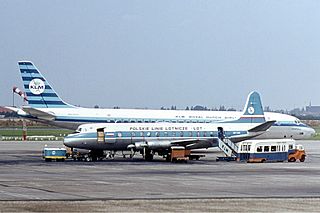
Cyprus Airways (Public) Ltd. was the flag carrier airline of Cyprus. It was established in September 1947 and ceased operations on 9 January 2015. Cyprus Airways had its operating base at Larnaca International Airport.

The Vickers Viscount is a British medium-range turboprop airliner first flown in 1948 by Vickers-Armstrongs. A design requirement from the Brabazon Committee, it entered service in 1953 and was the first turboprop-powered airliner.

British European Airways (BEA), formally British European Airways Corporation, was a British airline which existed from 1946 until 1974.

Indian Airlines was a state-owned airline in India that later became a division of Air India Limited before ultimately ceasing operations. It was based in Delhi and focused primarily on domestic routes, along with several international services to neighbouring countries in Asia and limited flights to the Middle East and South-East Asia. It was a division of Air India Limited after the merger of eight pre-Independence domestic airlines.
This is a list of aviation-related events from 1958.
This is a list of aviation-related events from 1960.
This is a list of aviation-related events from 1963.
This is a list of aviation-related events from 1974.
This is a list of aviation-related events from 1977.
Middle East Airlines – Air Liban S.A.L., more commonly known as Middle East Airlines (MEA), is the flag carrier of Lebanon, with its head office in Beirut, near Beirut–Rafic Hariri International Airport. It operates scheduled international flights to Asia, Europe, the Middle East, and Africa from its base at Rafic Hariri International Airport.

United Airlines Flight 389 was a scheduled flight from LaGuardia Airport, New York City, New York, to O'Hare International Airport, Chicago, Illinois. On August 16, 1965, at approximately 21:21 EST, the Boeing 727 crashed into Lake Michigan 20 miles east of Fort Sheridan, near Lake Forest, while descending from 35,000 feet (11,000 m) mean sea level (MSL). There was no indication of any unusual problem prior to impact. All 30 persons aboard, including six crew members and 24 passengers, were killed.

Mangalore Airport is located 2 nautical miles west Mangalore, Victoria, Australia. The airport is about 2 hours north of Melbourne by road, and is home to Inbound Aviation

Channel Airways was a private airline formed in the United Kingdom in 1946 as East Anglian Flying Services.

On 17 February 1959, a Turkish Airlines Vickers Viscount Type 793 on an international charter flight from Esenboğa International Airport in Ankara, Turkey, to London Heathrow Airport diverted to London Gatwick Airport, United Kingdom due to heavy fog. It was carrying the Turkish prime minister and a party of government officials. The Viscount crashed in a wood 3 miles (4.8 km) from the threshold of Gatwick runway during its final approach to land in extensive fog. Five of the eight crew and nine of the 16 passengers died in the crash. The prime minister was among the ten survivors.
Ankara Güvercinlik Army Air Base, is a military airport of the Turkish Army located in Güvercinlik of Etimesgut district, 10 km (6.2 mi) west of Ankara in central Turkey.

Central African Airways Flight 890, a Vickers Viscount 745D, crashed during a scheduled passenger flight from Wadi Halfa, Sudan, to Benghazi, Libya, about nine kilometers southeast of Benina International Airport in Libya. A total of forty-seven passengers and seven crew members were on board of whom only eighteen survived, making it the deadliest ever plane crash in Libya at the time of the accident. It still remains the deadliest accident for Central African Airways.
Cengiz Topel Naval Air Station, a.k.a. Topel Airport or formerly Cengiz Topel Air Base, is a Turkish Navy air station located east of İzmit in Kocaeli Province, Turkey. The airport is in joint use for military and civil. Restructured in 1976, it hosts the Turkish Naval Aviation Command with two flying units, the 301st Squadron of fixed-wing aircraft and the 351st Squadron of rotorcrafts.

The 1962 LOT Vickers Viscount Warsaw crash occurred on 19 December 1962 when a Vickers Viscount 804, operated by LOT Polish Airlines on a flight from Brussels to Warsaw, crashed on landing. All passengers and crew died.











